Happy spider collecting!
Yours For 8 Eyes
A Blog about jumping spiders for all those who are curious, afraid or just plain interested in these fascinating little predators.
07 July 2014
How to catch a Jumping spider!
Greetings fellow spider enthusiasts! Just a quick post for you today as I happened to stumble across a video that was entirely too good not to share. The video below is a primer on how to catch salticids in the wild. The video features Dr. Wayne Maddison, one of the world's foremost experts on salticids. Please take a few minutes and watch this highly informative video, as I can virtually guarantee that you will learn something new, I know I did! Also, if you'd prefer to watch it in a new window, just click the link below the video.
03 July 2014
Visiting blog post
Hi guys,
I know I've been super quite of late, and I apologize for that. However, I do have a guest blog posting over at http://www.wildlensinc.org/blog/ that you should all totally check out! The blog is run by a good group of conservationists and I'm sure they would appreciate your taking the time to peruse their work.
Also just FYI, this blog will be quite for a little longer yet as I am finishing up my dissertation and it is eating all of my time currently. Expect a new post around the last week in August (my turn in date), if not sooner!
Happy spidering!
I know I've been super quite of late, and I apologize for that. However, I do have a guest blog posting over at http://www.wildlensinc.org/blog/ that you should all totally check out! The blog is run by a good group of conservationists and I'm sure they would appreciate your taking the time to peruse their work.
Also just FYI, this blog will be quite for a little longer yet as I am finishing up my dissertation and it is eating all of my time currently. Expect a new post around the last week in August (my turn in date), if not sooner!
Happy spidering!
07 February 2014
Is that a spider-ant or an ant-spider?
Have you ever seen one thing and thought that it looked remarkably like something else, only to realize that it was in fact entirely different from what you thought it was in the first place? Yeah, me too, and usually its because the "something else" was a mimic of the object you initially thought you were looking at the first time. Confused yet? Good!... Wait, no, bad. Here, let me try again with some pictures and a quiz! Don't worry, its a simple one. All you have do to is decide whether each image is an ant or not.
Ready?
GO!
 | |||
| Ant or Not? |
| Ant or Not? |
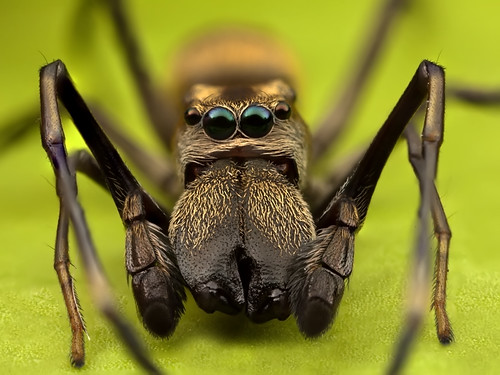 |
| Ant or Not? |
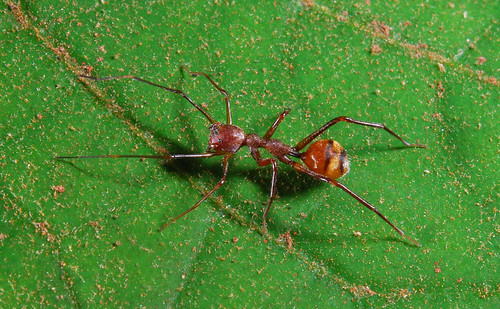 |
| Ant or Not? |
Great! How did you fair? If you said that they were all NOT ants... you were correct! That's right, those remarkably ant-like creatures are impostors, and in fact all of them are actually salticids! Scientists refer to ant-mimicking creatures as Myrmecomorphs (Myrmeco- meaning ant, and -morph meaning appearance). Myrmecomorphs are found in several different spider families as well as in several other arthropod groups like beetles, flies and assassin bugs. The real question though, is why would you want to look like an ant? The answer might surprise you...
Ants are ubiquitous (everywhere) and as such, they tend to play a disproportionately large role in the environment around them. Many creatures have specialized to feed on ants, but even more have evolved ways of avoiding ants. Why would they bother avoiding such a small and seemingly insignificant creature? For starters, ants can live in very large (>1,000,000 members) colonies that function as a single unit. This is very evident when they are out foraging (looking for food) in large numbers. Ants have evolved to swarm and overcome larger objects through sheer numbers. Most ants have also evolved the ability to defend themselves, usually through biting and/or stinging. Now apply that defensive capability to an entire group of parading ants...
 |
| Remember what happened to Gulliver when he met the Lilliputians? |
This idea of being swarmed applies to most creatures if they are caught off guard, and therefore they avoid the ants. Think of it this way, one ant at your picnic seems unimportant, while a column of aggressive, hungry ants is a definite problem. But what if you could take advantage of this quasi-universal avoidance of ants that many creatures possess? This is exactly the idea behind myrmecomorphy.
Myrmecomorphs are a special type of mimic known as a Batesian mimic. Batesian mimics are creatures who look like dangerous or harmful creatures without actually being dangerous themselves. While some of you may not agree that salticids (or spiders in general) are harmless, compared to the power of an ant colony they quite safe, and to my knowledge, there are no medically significant myrmecomorphic spiders. But I digress...
By living under the guise of an ant, myrmecomorphic spiders are able to go places disguised as ants without worrying about predators recognizing them as salticids. Indeed, a few different studies have shown that predators do not recognize myrmecomorphs are spiders, but rather treat them as they do ants. However, this also means that predators who specialize on ants are more likely to eat a myrmecomorph than they would be if they didn't look like an ant. Like so many adaptations, myrmecomorphy is a double-edged sword.
Myrmecomorphs are fascinating little creatures, especially those in family salticidae. A lot of research has been conducted on these morphological marvels encompassing things like myrmecophily (living with ants), myrmecophagy (feeding on ants) and mate recognition/distinction as a myrmecomorph. Dr. Paula Cushing has conducted some fascintating studies on this topic. If you're as fascinated by these tiny "costumed" spiders as I am, you can read her review article here. It covers a lot of the basics and is a great starting point for future reading.
Happy Spidering!
18 December 2013
Robotic Salticids are taking over the world!
Well, ok maybe not so much... yet. However, the ground work has been laid! This stunning little piece of technology has me completely flabbergasted
with its realistic motion and definitely wishing I had a LOT more
disposable income. Take a look at the video below for a really nice demonstration by MythBuster's Adam Savage. If you'd rather skip most of the technical talk, jump to ~6:00 into the movie, though the whole thing is definitely worth watching.
Fine, fine, ok you win. The take over, if it ever happens is still a long way off. However, what this little invention does represent is the best robotic model of a spider's movement I've seen to date. Not only does the robot move with the appropriate leg pattern, but it even tilts and rotates properly. While it is very fragile still, the potential applications for this device are pretty astounding, especially for out reach purposes. A bit of paint, some plastic eyes to cover the admittedly cool monocular "eye," and you'd have quite the handy tool for teaching. I wonder if we could get some gecko tape for the feet... hmmm...
Fine, fine, ok you win. The take over, if it ever happens is still a long way off. However, what this little invention does represent is the best robotic model of a spider's movement I've seen to date. Not only does the robot move with the appropriate leg pattern, but it even tilts and rotates properly. While it is very fragile still, the potential applications for this device are pretty astounding, especially for out reach purposes. A bit of paint, some plastic eyes to cover the admittedly cool monocular "eye," and you'd have quite the handy tool for teaching. I wonder if we could get some gecko tape for the feet... hmmm...
24 October 2013
Just how big is salticid?
The question du Jour is "Just how big is a salticid?" and to answer that we will require some background info first. Salticids come in a wide variety of sizes, however, modern salticids are very small compared to many other spiders. Why these size constraints exist has never been examined to the best of my knowledge, though I would suspect it's due to a combination of phylogenetic inertia (i.e. they've always been small) and the fact that most of them feed on very small prey items, making a larger size impractical from a foraging perspective. Just think, if salticids were the size of small dogs like dachshunds, who would be on the menu then...
In reality, most adult salticids fall between 1mm and 22mm in length, with most being less than 10mm in my experience. However, as you can see below, juveniles can be significantly smaller.
On the other end of the scale is this giant male, who is identified by the videographer as Hyllus diardi, though I cannot confirm this. The bad news is that he is a living nightmare for those of you who are even slightly arachnophobic. The good news? He seems very friendly! If you'd like to see the original video, it and a few others can be found on youtube here.
Having now seen the full breadth of salticid size, I will leave you with these two beautiful photos of some lovely little spiders.
Happy Spidering!
 |
| Can I come over for dinner? |
In reality, most adult salticids fall between 1mm and 22mm in length, with most being less than 10mm in my experience. However, as you can see below, juveniles can be significantly smaller.
 |
| A juvenile salticid sitting on the head of an American penny. |
On the other end of the scale is this giant male, who is identified by the videographer as Hyllus diardi, though I cannot confirm this. The bad news is that he is a living nightmare for those of you who are even slightly arachnophobic. The good news? He seems very friendly! If you'd like to see the original video, it and a few others can be found on youtube here.
Having now seen the full breadth of salticid size, I will leave you with these two beautiful photos of some lovely little spiders.
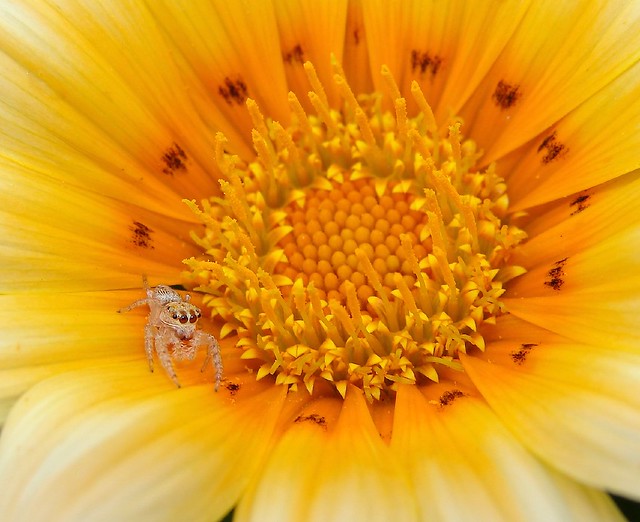 |
| Not the smallest, but by no means a giant either. And yes, those are pollen grains you're seeing next to it. Also, my apologies to the original photographer, but I seemed to have lost the attribution information... |
 |
| Its so TEENY! |
Happy Spidering!
13 September 2013
Macro-tacular Salticids
Today's long-delayed post is nothing short of a shameless excuse to peruse some of the best Macro-photography on Salticids present on the web. I will take you on a guided tour of some of the best shots I know of and hopefully even help identify some of what your looking at in the photos. After all, knowledge only makes things more appealing and interesting! Just by way of disclaimer, none of the following images are mine, and the species labels, while educated guesses, should not be treated a positive identifications as the specimen was not available for me to key out properly.
Our first photo is a lovely close up of a Phidippus species. This specimen is likely from the species P. mystaceus, given the extremely large black tufts around the eyes and the bright yellow legs.
 |
| Borrowed from http://25.media.tumblr.com/tumblr_lvys4wWKLO1r3p20do1_500.jpg |
Our next lovely model is almost certainly from the genus Lysomannes as there are very few other salticids with such a bright green complexion.These tiny salticids are known for their ability to jump very well (even for a salticid) and frequently catch flying prey by pouncing on it mid-air as it flies by!
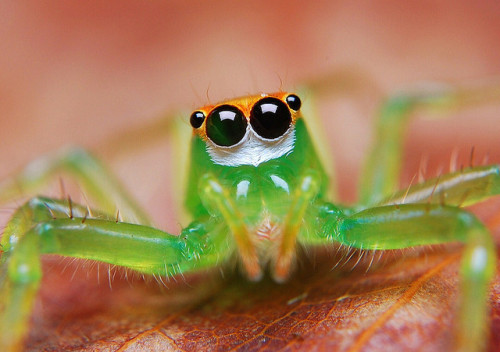 |
| Borrowed from http://24.media.tumblr.com/tumblr_mc8xsb5Oo51rob773o1_500.jpg |
This lovely ant is... wait a minute, that's no ant, its a salticid in disguise! If you take a very close look, you can see the telltale signs that we have a myrmecomorph (ant-mimicking spider) on our hands! While I am unsure as to the species, or even the Genus of the animal, I think we can all agree that it does a remarkable job of looking like its intended victims. Many species that adopt this form of mimicry feed on ants and even live in the nests of those they hunt. However, there are also mimics that only use the ants for protection and either steal food from them or else specialize in foraging near ant lines and colonies. A fascinating way to outsmart one of the salticids most dangerous enemies!
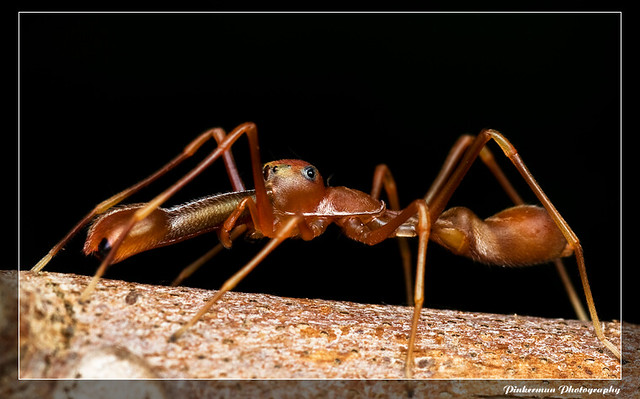 |
| Borrowed from http://farm5.staticflickr.com/4149/5050635255_aa3abe82a8_z.jpg |
Our final red-faced friend is from the Genus Habronattus. The photographer has identified the animal as H. americanus. Habronattus are generally tiny animals and are frequently no more than a few millimeters in length. They are also quite adept at jumping, much more so than this counterparts in the genus Phidippus.
 |
| Borrowed from http://bugs.adrianthysse.com/wp-content/uploads/2013/08/Habronattus-americanus-21-04-2013-5-31-36-PM.jpg |
I hope you've enjoyed this brief macro tour of salticids. For the next post, I'm planning something a bit more meaty in terms of content, but every so often its nice to have fun with these beautiful animals. As the Summer draws to a close, I encourage you to go out and enjoy these amazing little animals one last time before winter sends them scurrying for a long, and undoubtedly well deserved, nap.Happy watching!
30 July 2013
Spider Documentary
Greetings Dear Reader!
Today's post will be a brief one, and possibly slightly off topic as well. I just found out about a National Geographic documentary on spiders. Having watched it in its entirety last night, I can say that it is well worth watching, especially if you can ignore the overly dramatic music. Unfortunately, it does not focus exclusively on jumping spiders. However, it does have a nice segment on salticids and even features a few well respected researchers, such a Beth Jakobs, whose publications are well worth your time. Happy watching!
Today's post will be a brief one, and possibly slightly off topic as well. I just found out about a National Geographic documentary on spiders. Having watched it in its entirety last night, I can say that it is well worth watching, especially if you can ignore the overly dramatic music. Unfortunately, it does not focus exclusively on jumping spiders. However, it does have a nice segment on salticids and even features a few well respected researchers, such a Beth Jakobs, whose publications are well worth your time. Happy watching!
Subscribe to:
Posts (Atom)